

Professional BoatBuilder Magazine
Delphine ii, the last big steam-powered yacht.
By Gérald Guétat , Sep 1, 2016

Original blueprint of the SS Delphine II .
At the origins of the Dodge industrial empire were two inseparable brothers, Horace and John, natives of a small Michigan town. The family was poor and the Dodge boys went to school barefooted. John preferred to look after horses, while his younger brother admired the passing boats on the nearby river. They had a younger sister, named Delphine. Horace loved above all to tinker, to invent small machines, and to play the piano, and his brother never seemed to raise his nose from reading books. At the turn of the 1900s, the Dodge brothers opened a little bicycle factory before operating a machine tool workshop. Horace had a genius for assembling high-precision parts. Soon, growing firms like Oldsmobile and Cadillac could not do without their subcontractor, the Dodge Brothers Company. Henry Ford also needed their services to manufacture some essential components for his first cars. As money to pay his bills was short, Ford offered to pay the two brothers in shares of his company. The Dodges’ fortune was made.
Horace Dodge could give free rein to his childhood love of boats. In 1903, when he was 35 years old, he bought his first 40 ‘ (12.2m) launch. The long, slender hulls of those touring launches were powered by steam engines designed and built by their owner. In 1910, he commissioned architect Henry John Gielow to design the 183 ‘ (56m) Nokomis , the family’s first large cruising yacht, powered, not surprisingly, by two Dodge steam engines. Following the 243 ‘ (74m) Nokomis II , in 1918, the automaker had Gielow design an even more prestigious yacht. The Great Lakes Engineering Works of River Rouge, Michigan, was in charge of constructing the largest steam yacht ever built in the U.S. Its length had to be limited to 262 ‘ (80m) to fit the locks of the Welland Canal and the Saint Lawrence River.
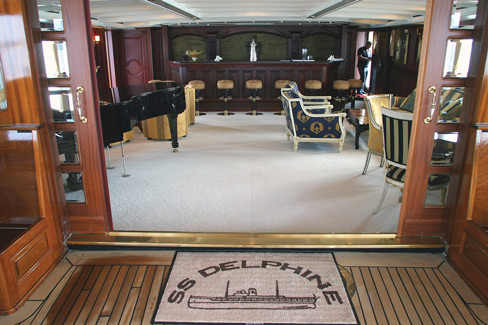
The main stateroom with piano and bar was restored, including the sliding windows with levers. On the bar is a thermos bottle in the shape of a coastal light, a gift from the Dodge family to Bruynooghe, recognizing Delphine II ’s renaissance.
This private ocean liner, built of 12mm-thick steel, was christened Delphine II in homage to Horace’s sister and to his young daughter. Onboard saloons, smoking rooms, a great staircase, apartments with fireplaces and bathrooms, all paneled with precious woods, could host about 18 guests and a crew of 52. Horace Dodge decided he would personally design the engineroom with two quadruple-expansion engines of 1,500 hp (1,125 kW) each. Horace Dodge died of pneumonia three months before the launching of his masterpiece. His brother John followed him a few weeks later, struck by the same illness. On April 2, 1921, Horace’s daughter swung the traditional bottle of champagne on Delphine II ’s hull.
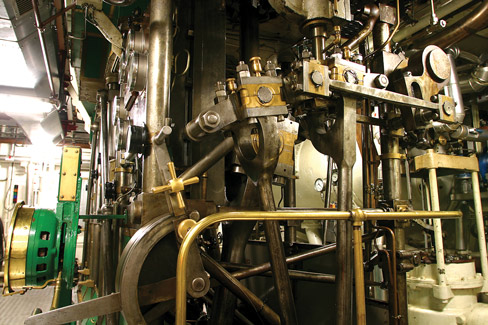
The two 1,500-hp (1,125-kW) quadruple-expansion steam engines were designed by Horace Dodge, who died just three months before the launching.
In 1925, Anna Dodge, Horace’s widow, and her sister-in-law made a fortune by selling their shares in the family business. Anna Dodge fitted the yacht for long-range cruising. The great steamer then voyaged around the Great Lakes and along the East Coast. During a stopover in New York, a fire sank the boat. The owner, who fortunately was not on board, had it raised and completely repaired by Brooklyn Shipyard.
Soon after the United States entered World War II, Anna Dodge received a requisition order from the U.S. Navy. In May 1942, the steam yacht was convoyed by a military crew from Detroit to Washington, where the Navy armed her with guns, painted her green and gray, and renamed her USS Dauntless . She was then assigned to the command of the chief of naval operations as the flagship of Admiral Ernest King. The USS Dauntless voyaged little during the war years but served as a residence and remote meeting place reserved for high-ranking officials. After the Japanese surrender, Delphine II was returned to her private owner, who refit her at great expense.

During World War II, the 262′ (80m) Delphine II was conscripted by the U.S. Navy, armed, painted camouflage colors, and renamed USS Dauntless .

Even Jacques Bruynooghe’s impeccable restoration wasn’t able to make the chartering enterprise a success.
But times had changed and steam yachts definitely belonged to a bygone era. The aging ship, no longer of interest to the family, was entrusted in 1968 to a merchant marine academy. In 1989, a Singapore-based company bought the old vessel and sent it from America to Asia with a long stopover in Malta. Next, a French business group moved her to Marseille, where she was later abandoned. In 1997, Jacques Bruynooghe, a Belgian textile industrialist, came to the rescue, planning a huge restoration project and a charter business. The restoration took about six years. The steam engines underwent a fascinating reconstruction.
In 2003, Delphine II was relaunched as the last and only large steam yacht in the world, but Bruynooghe’s charter business was not successful. He put her up for sale in 2004 for € 46 million, reduced 12 years later to € 16 million. Today, this rare witness to a glorious era lies in Monaco awaiting a new owner. It’s listed for € 19.75 million on www.jamesedition.fr.
[A longer version of this article was published in Classic Superyacht magazine in January 2012 . ]
Read more Rovings articles

- From Langan Design Partners, a Classic Cutter
Designing, engineering, and building sailing yachts 90′ (27.4m) or more in length once was common in the U.S. It’s happening again at Rockport Marine in Maine: Project Ouzel, a 95′… Read more »

- Isobel Combines Classic Looks and Modern Tech
From the drawing board of Stephens Waring Design (Belfast, Maine) comes Isobel, a 26’6″ (8.5m) 1950s-inspired runabout being built at nearby Belmont Boatworks. The boat was commissioned by a longtime… Read more »

Raptor Deck: From Startup to Global Supplier
“We had no inkling of creating a business or anything. It was just a total fluke.” Dan Kaseler still chuckles when he relates the story that led him to start… Read more »

Recent Posts
- AIRMAR Achieves World’s First OneNet Product Certification
- Infusing a Workboat Hull with Elium
- Counting Carbon with LCA
- Companies (91)
- Construction (115)
- Design (168)
- Drawing Board (11)
- Education (29)
- Environment (18)
- Events (22)
- Materials (55)
- Obituary (18)
- People/Profiles (49)
- Products (18)
- Propulsion Systems (35)
- Racing (17)
- Repair (37)
- Rovings (326)
- Short Cuts (3)
- Sponsored Partner News (19)
- Systems (80)
- Task Sheet (1)
- Uncategorized (28)
- Wood to Glass (8)
ProBoat.com Archives
The 101-year-old classic yacht that runs on steam

The SS Delphine is an iconic yacht that reached a major milestone in April 2021: celebrate its 100th birthday . Now, a year older, the yacht has been renovated on the inside but still uses steam to move around.
“She is the only superyacht in the world still operating today with her quadruple expansion steam engines,” -Emmanuel R Buetss, SS Delphine’s Manager.
SS Delphine’s origins
Although it was built for Horace Dodge , American automobile manufacturer pioneer, the 78-metre yacht has hosted heads of states while they planned peace treaties . SS Delphine was launched in 1921 at Great Lakes Engineering Works . At that time, she had the largest gross tonnage of any yacht in America.
Originally it was equipped with Babcock & Wilcoz boilers. These supplied power for her two 1,500-horsepower steam engines. However, the engine room was updated in 2003 during a refit. Now, two modern water-tube boilers that power the original engines.
In 1926 the SS Delphine was almost destroyed after catching fire and sinking in New York. However, she was miraculously salvaged and restored.
Christened as the USS Dauntless
In 1942 SS Delphine was requisitioned by the US Navy and christened the USS Dauntless. During this time, she served as the flagship for naval commander Admiral Ernest King during WWII.
Once the war was over, she hosted US president Franklin D Roosevelt, vice president Harry S Truman, UK prime minister Winston Churchill and Russian diplomat Vyacheslav Molotov . This was when they prepared for the Yalta Conference, the event that determined how Europe would be reorganised after the war.
“The privileged status of having been Admiral Ernest King’s ship certainly helped her avoid the unfortunate fate of other steamships that did not survive the war, allowing her to delight us today with her original splendor.” -Buetss
Times of changes
Once WWII was over, she returned to the Dodge family. However, over the next 50 years she changed of owners on several occasions. As a result, by 1997 her condition had worsened, so although the owner paid a low price for the vessel he had to pay €45 million to restore the iconic yacht to its former glory.
During the five-year restoration, her original Tiffany décor layout and design was kept as possible.
“That is indeed why sailing on board the SS Delphine is not only a maritime journey, but above all a journey through time that takes us back to the Belle Époque of the 1920s in the decorations, carvings, wall patterns and carpets that are exact replicas of the 1921 plans,” -Buetss
Current times
In 2003 the yacht changed names once again, this time by HSH Princess Stephanie de Monaco. Now, the current owners offer exclusive events aboard the yacht and charters in the Mediterranean.
You might find interesting: How expensive is it to charter a luxury yacht?
“Sailing on SS Delphine is not only a visual pleasure but also the opportunity to enjoy a steam engine which, beyond its timeless aesthetics, also offers a unique noiseless and vibration-free comfort forgotten by the hectic modern machines,” -Buetss
The SS Delphine can receive up to 26 guests to sleep onboard and up to 150 guests for day events . Moreover, she is now equipped with modern comforts expected from a charter yacht: she has a sauna, jacuzzi, hammam, gym, swimming pool and a dressing room. This together with her Tiffany décor in her dining rooms, lounges and suites make her a unique vessel.

WE AND OUR PARTNERS USE COOKIES ON THIS SITE TO IMPROVE OUR SERVICE, PERFORM ANALYTICS, PERSONALIZE ADVERTISING, MEASURE ADVERTISING PERFORMANCE, AND REMEMBER WEBSITE PREFERENCES. BY USING THE SITE, YOU CONSENT TO THESE COOKIES. FOR MORE INFORMATION ON COOKIES INCLUDING HOW TO MANAGE YOUR CONSENT VISIT OUR COOKIE POLICY .

- Current Issue
- Back Issues
- Communities
"SS Delphine" – A 257-foot Steam Yacht
By: rick casali.
One of the largest private yachts ever built and sailed on the Great Lakes and the St. Lawrence River is the 257-foot steam yacht Delphine . She was built in 1921 for Horace Dodge Sr., co-founder of the Dodge Brothers Automobile Company. The massive yacht was built near Detroit in River Rouge, MI, by the Great Lakes Engineering Co., at a cost of over $2 million.
Delphine is powered by twin quadruple-expansion steam engines that produce 1,500 horsepower each. Mr. Dodge designed these large engines, which still operate the yacht today. They turn only about 150 revolutions per minute, which is awfully slow compared to modern marine engines. And they are said to be quite easy on fuel oil. Delphine cruises at 9 knots and she has a range of about 2,500 nautical miles. She was reported to have a top speed of 15 knots. The yacht carries over 200,000 gallons of fuel oil, as well as over 300,000 gallons of fresh water.
Horace and John Dodge were hugely successful in the automotive business. Initially, they supplied axles, engines, and other components to Henry Ford and other manufacturers. Eventually, they made the decision to build their own motorcars under the Dodge name, and were known for durable and dependable automobiles, sold at a competitive price. Having accumulated millions of dollars in wealth, they built large mansions in Grosse Pointe, MI, as well as motor yachts – all of which were the result of their ingenuity and driven business habits.
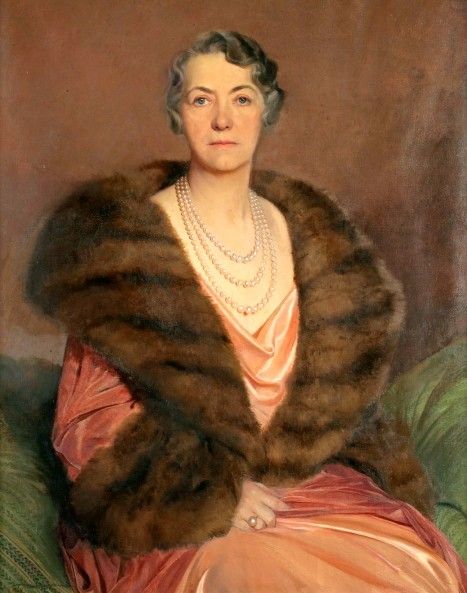
Unfortunately, Horace Dodge and his brother John never got to enjoy or sail on Delphine as they both died of influenza in 1920, after attending the National Automobile Show in New York City. At the time of their deaths, they were only about 55 years of age. Horace’s wife Anna took over control of Delphine, and the Dodge family cruised her through the Great Lakes, the St. Lawrence River, and on the East Coast. While at anchor on the Hudson River in 1926, Delphin e caught fire, and partially sank. Under Anna’s direction, she was re-floated and restored. In 1940, Delphine struck a rock off Manitoulin Island, ON, in Lake Huron, and again went through some restoration and repairs.
During WW II, the Dodge yacht was requisitioned by the US Navy and was re-named the USS Dauntless. She became the flagship of Admiral Ernest King, who was Commander-in-Chief of the US Atlantic Fleet. It also reported that during WW II, US President Franklin Roosevelt, British Prime Minister Winston Churchill, and Russian Ambassador Molotov had a secret meeting to discuss war strategy, in the smoking room of the large yacht. Following the war, she was used as a training vessel for steam yachts by the Lundenberg Maryland School of Seamanship. She went through a series of owners over the following 18 years. At one point, she was considered being sold for scrap metal.
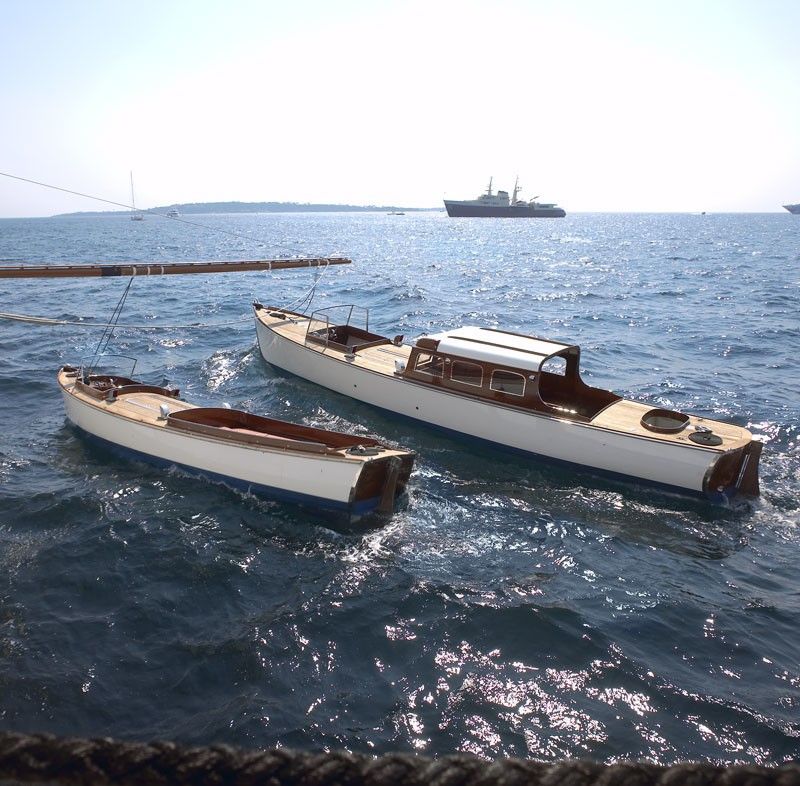
Delphine , which was named for Horace and Anna Dodge’s daughter, was ultimately restored, and sold for $22 million. Another massive five-year restoration from stem to stern was finished in 2003, and was reported to cost 45 million Euros. She was owned by the Tunisian Ineke Brunynooghe – who apparently does not like to fly. Upon completion of the restoration, Princess Stephanie of Monaco re-christened the vessel. Today, she flies the flag of Portugal, and is available for charter.
Delphine has 11 staterooms, which can accommodate 24 guests. The guest staterooms are 14 by 14 feet, each with a private bath. The owners’ stateroom is 25 by 25 feet. Delphine has a swimming pool, massage suite and spa, a gourmet galley, a small hospital, and about 3,000 square feet of deck space. She has five decks, and originally had a crew of 54. Today, a crew of 32 is the norm. The living spaces in the interior were designed by Tiffany’s. One of her features was the installation of a $60,000 organ. Today, the organ has been replaced by a Steinway grand piano.
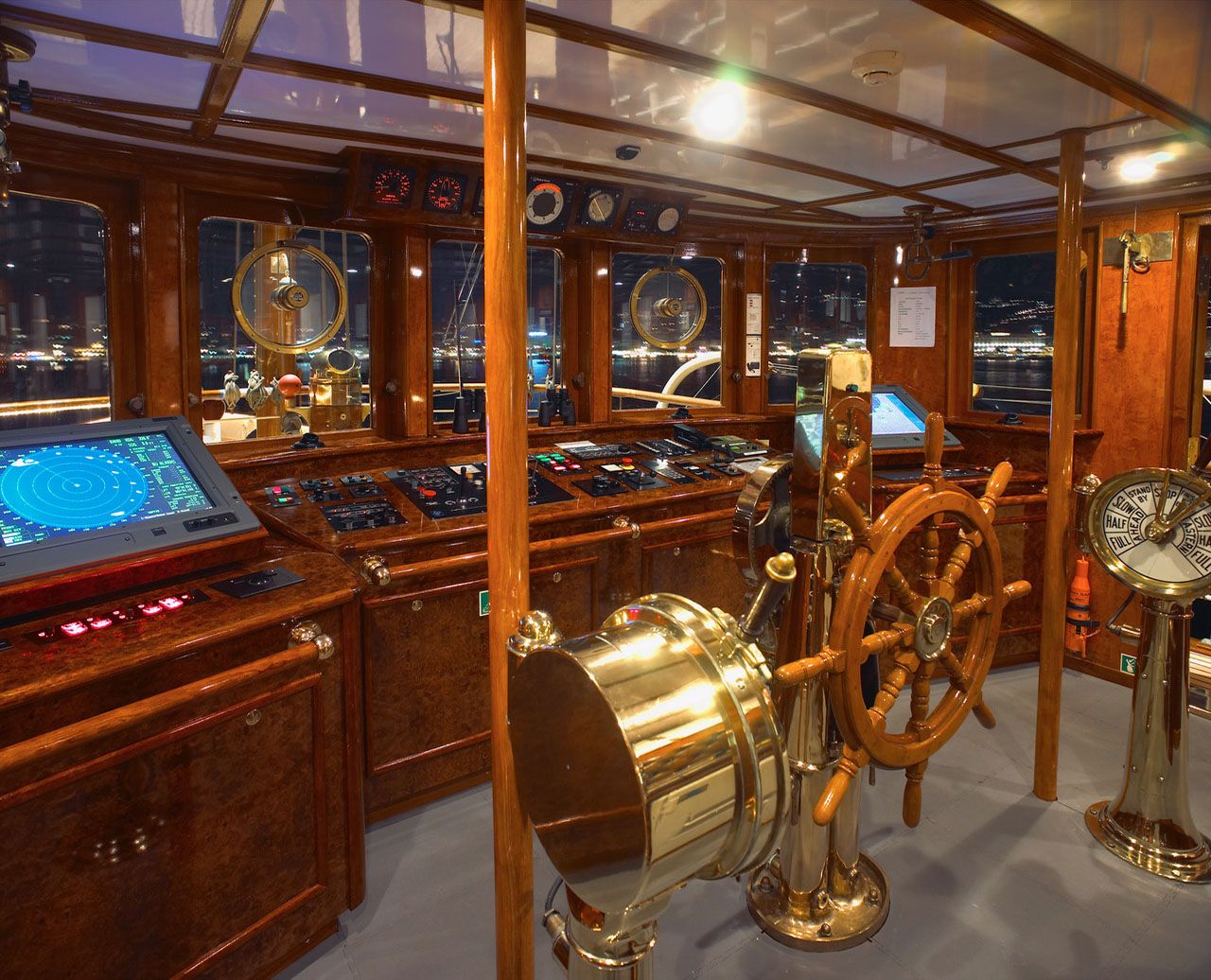
In terms of support vessels, Delphine originally had two 20-foot launches for the captain and crew; a 30 foot launch; and a 35-foot express launch for owners and guests that was capable of doing 40 miles per hour. The 1,700-ton vessel has a beam of 36 feet and draws an amazing 14 feet.
Today, Delphine is available for charter in the Mediterranean Sea, and frequents ports in France, Monaco, Italy, and Greece. This luxury yacht has all the water toys and modern comforts that wealthy charter clients expect. Many Grand Prix drivers have visited Delphine , as she is frequently anchored in Monaco for the famous auto race.
During her history of cruising US waters, it is evident that Delphine transited the St. Lawrence River and Thousand Islands a number of times. Her 14-foot draft would have limited where she could find a berth in the Islands. Mrs. Dodge had good friends in Cape Vincent, and visited them on the Delphine . Alexander and Lucy Rutherford, who owned the Windy Bank estate, entertained Mrs. Dodge on more than one occasion. The property, at the northwest corner of Broadway and Real Streets, and is now owned by David and Sharon Wiley. It is also reported that Mrs. Dodge enjoyed having dinner at the Carleton Hotel, while in the Cape Vincent area aboard the Delphine . The Rutherfords were also entertained by Mrs. Dodge aboard Delphin e on numerous occasions. Her last visit to Cape Vincent was in June, 1955. Mrs. Dodge passed away at her home in Grosse Pointe Farms, MI, on June 2, 1970 at the age of 103. Thus far, I have not been able to uncover any photos of ports-of-call that Delphine made while in the Thousand Islands or Lake Ontario.
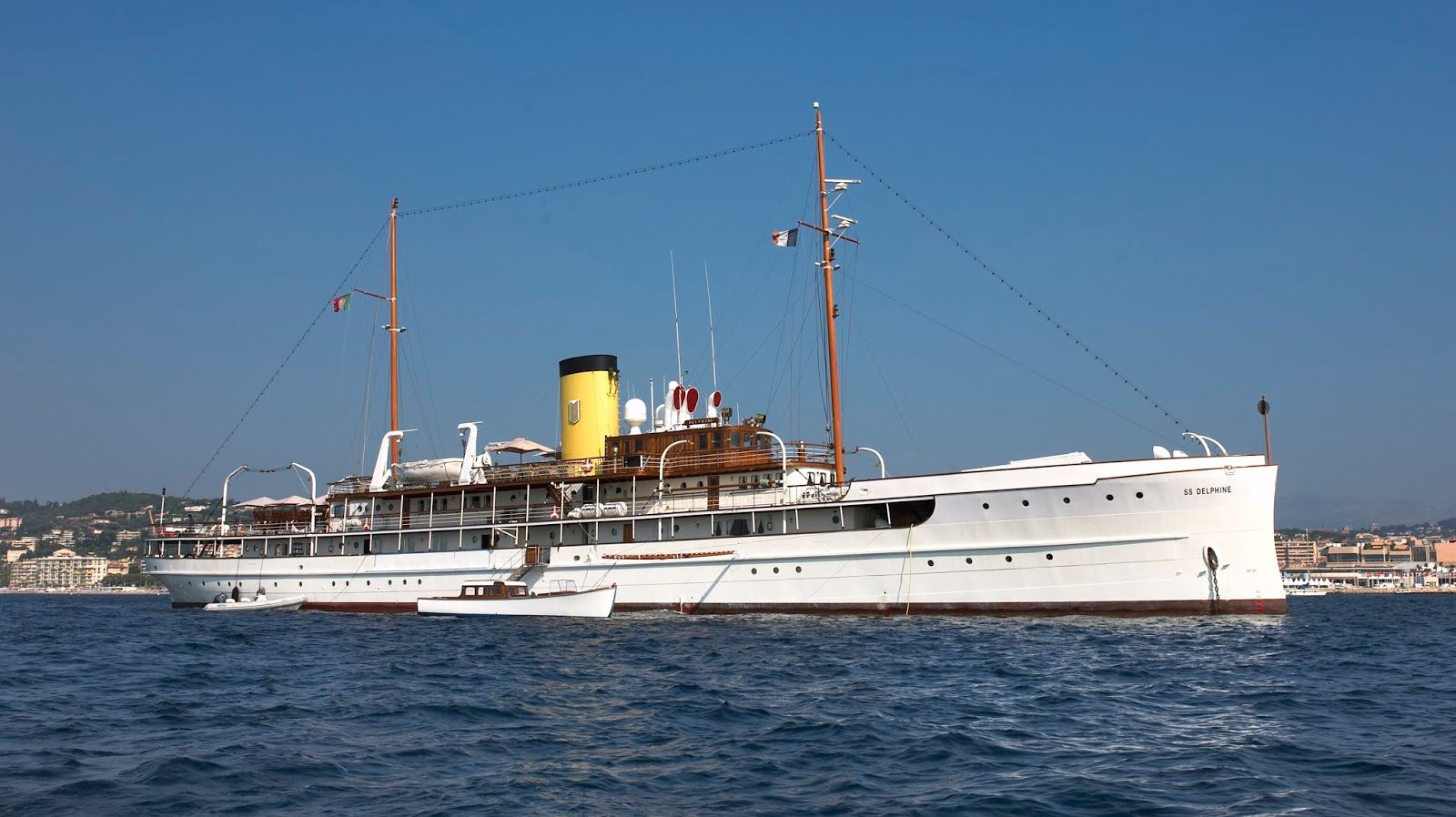
Some say that her design length of 257 feet was limited by the capacity of the Welland canal and locks. In the 1920’s, Delphine was the largest private yacht to pass through the locks. The tragic story of owner Horace Dodge, not ever able to enjoy his nautical dream, reminds me of the story of George Boldt and Boldt Castle. It is ironic how health can change the future, despite incredible wealth.
By Rick Casali
Rick Casali is a resident of Wellesley Island. During his youth, his parents had a cottage from 1947 to 1970 named The Orchards on Grindstone Island. Rick now splits his time between Stuart, Florida and the River. He worked for Columbia Gas System for 29 years, and ran their Washington, DC office. Then in 2000, he started brokering boats and yachts, and continues as a broker with North Point Yacht Sales. Rick and his wife Anne cruise the River in a Seaway 24 Seafarer named "Miss Annie" and they live on Tennis Island.
Be sure to see more of Rick Casali's tributes and reviews . He had now written over a dozen and they are not only interesting but provide an important historical review of River life.
Posted in: Volume 18, Issue 12, December 2023 , People , History , Places , Sports
Please click here if you are unable to post your comment.
Submit an Article
Do you have an article you would like to submit? Click here to participate .
Rick Casali
Read more articles by Rick Casali and there may be more articles on our old site. Click here to visit our old site.
You Might Be Interested In
Raccoon hunting with uncle aaron.
Uncle Aaron was a true outdoorsman; he knew how and where to catch squirrels, how to find wild honey trees, where to gather hickory nuts, how to trap a muskrat, and where the fish were biting – a true man of all seasons.
The Making of "Drain the American Revolution" on Carleton Island and Cape Vincent
On Tuesday, June 2nd, 2020, National Geographic released the TV program “Drain The American Revolution”. Two British ships, The HMS Ontario and HMS Haldimand are included.
"The Wind in the Islands," an Animated Audio Book for River Rats...
An animated audio book version of The Wind in the Islands... Performed by Scott's daughter, Merideth, and featuring Scott's animated drawings,
Gliding Back in Time
What better way to start a day on the island than with a row in a St. Lawrence River Skiff?

ULTIMATE RESTORATIONS: Cangarda: The Last American Steam Yacht (Series Premiere)

Airs Monday, February 16, 2015 at 10 p.m. on KPBS TV
KQED presents a new eight-part series, ULTIMATE RESTORATIONS , featuring the spellbinding restorations of irreplaceable masterpieces. ULTIMATE RESTORATIONS showcases the rescue and restoration of some of the most valuable mechanical icons of the Golden Age (1880-1940), a high point in innovation and craftsmanship. The series, hosted by Bob McNeil, tells the spellbinding stories behind eight of American history’s greatest historical and engineering treasures — the world’s largest pipe organ ; a surviving 1920s fire engine ; a “fish car” designed to transport live fish by train ; a priceless carouse l; a World War II spy plane ; one of the first U.S. yachts to round Cape Horn and a famous steam locomotive . The passionate restorers and committed craftspeople discuss the challenges associated with reviving these massive icons to their original glory: moving huge pieces of equipment, salvaging from sea-floor beds, searching for rare parts, and dealing with complicated mechanical systems.

"Cangarda: The Last American Steam Yacht" - The last existing American stream yacht was nothing more than an eyesore stuck in the mud of the Boston harbor until Bob McNeil came to its rescue. His four-year restoration of the 136-foot vessel revives old construction techniques alongside new technologies with the help of the colorful crew of Rutherford’s Boat Shop in San Francisco. After 112 years and more than a few setbacks, the Cangarda finally sails again.
Monaco Classic Week

SS Delphine: the last big steam yacht
Privacy overview.
intheboatshed.net
Gavin Atkin's weblog for the sort of people who like looking inside boat sheds. It's about old boats, traditional boats, boat building, restoration, the sea and the North Kent Coast

Steam yachts of a century ago, from Jeff Cole’s collection

Dodo, Valhalla and Consuelo
Today’s gallery of photos are of steam yachts, and they belong to a collection that Jeff Cole acquired back when he was a teenager.
Except for Dodo he says they are all private steam yachts, mostly photographed at Cowes , and wonders what what happened to them?
On some odd cuttings that came with the photos, GL Watson is mentioned as a popular designer, and Thames, South Coast, Irish and Clyde yards are mentioned as building this kind of craft.
Dodo on Windemere appears in a supplement to The Yachtsman no. 504 published in December 1900. Photo by Brunskill of Windemere .
Alberta , owned by His Majesty the King of the Belgians appears in a supplement to The Yachtsman , no. 415, March 1899. Photo by J De Muevyuck .
Valhalla on hearing that she was third in an ocean race. Jeff thinks she may be a training ship. She appears in a supplement to Yachting World , June 1905. Photo by Illustration Bureau .
Consuelo appears in a supplement to The Yachtsman , no. 522, April 1901 Photo A. Debenham , Cowes . The warship in the background appears to have side-by-side funnels and two rigged masts. Aft, Jeff has identified what seems to be a gun extended at deckhouse level consistent with a barbette, and smaller traversing turrets below it, and so he thinks this is a Royal Sovereign Class ship . HMS Royal Sovereign was flagship of the Channel Squadron round this time, so it could be her.
Ombra was owned by Baron Von Schroeder appears in a supplement to Yachting World , December 1902. The designer: GL Watson, the builder D&W Henderson . She’s described as a steel twin screw schooner, with a Thames measurement of : 267 tons, and 140 by 20.1 by 12.5ft. Photo Kirk & Sons , Cowes.
Vista was owned by Mr WS Hunter , and appears in a supplement to Yachting World , May 1905. She was designed and built by W White & Sons , and is described as a composite screw schooner of 95 tons Thames measurement, and 98.4 by 14.6 by 7.7ft. Photo by West of Southsea . She has a fleur de lis at the forepeak, what appears to be a Royal Yacht Club pennant on the mizzen, and a White Ensign on the jackstaff. Under the bowsprit a full rigged ship can be seen in the distance.
Mirage owned by the Marquis of Ormonde , of the Royal Yacht Squadron. She appears in a supplement to Yachting World no.5, Vol 1, 1894. The image is a Photomezzotype by The London Stereoscopic Co . from a photo by W Kirk of Cowes. Jeff remarks that it is one of the earliest photos in his collection – some of the others are too badly foxed or undated. Note two other sailing yachts moored behind.
Erin as she was when she set out to cross the Atlantic . The image is a Photomezzotype from the Yachting World , thinks Jeff. The shot dates from the mid-1890s, but there is no other information. The ‘lights’ are white dots added to the image by hand, as are the letters ‘ERIN’ between the masts.
La Belle Sauvage appears in a supplement to Yachting World , January 1902. The photo is by Beken of Cowes . 1902 was the year of the Coronation Regatta. Note all sails are stowed in covers and the tropical awnings have been rigged.
Sabrina , Thames measurement 513 tons. She appears in a supplement to Yachting World , August 1899. Photo by Kirk of Cowes.
Oimara, 202 tons, as shown in a supplement to Yachting World , January 1903. Photo by Adamson , Rothesay . Jeff comments that there are canvas screens on the bridge, and that although she is under way she has gangplank rigged. Also notice the figurehead.
Shemara , pictured in a supplement to Yachting World , February 1900. Photo by Debenham , Cowes.
Vanduara , 450 tons, owned by Mr Stewart Clark. The photo comes from a supplement to Yachting World October 1894. It is a badly foxed Photomezzotype, but shows a female figurehead, and, Jeff thinks, a small un-rigged keelboat yacht in davits aft on the staboard side.
Paulina from a supplement to Yachting World published in May 1900. Photo by Kirk & Sons , Cowes.
Nirvana , owned by the Countess de Bearn , shown in a supplement to Yachting World February 1904. Photo by Robertson of Gourock . Jeff says there is a tricolor on the jackstaff, the figurehead seems a bird, and there is a crewman walking a boom rigged with a rope ladder to the dinghy.
Surf , 489 tons, as shown in a supplement the Yachting World , in November 1899. Photo by Debenham of Cowes.
Tuscarora shown in a supplement to Yachting World , February 1902. Photo Beken of Cowes. There’s a rope ladder over stern, and boats appear to be being prepared for launching.
The steel screw steamer Titania appeared in a supplement to Yachting World published in April 1905. She was designed and built by Day, Summers and Co and owned by Mr S. Taylor Chadwick . She was of 138 tons Thames Measurement, and measured 116.5 by 16.1 by 10.1ft. The photo is by Kirk of Cowes.
Researching the fate of these craft, Jeff found that the steam yacht Hiawatha – not pictured in this post – was acquired by the Royal Navy , which renamed her HMS Undine . She served at Sheerness and as flagship to the Commander-in-Chief of the Nore Fleet .
Thanks for the shots and information Jeff!

Share this:
6 thoughts on “steam yachts of a century ago, from jeff cole’s collection”.
My congratulations to Jeff Cole who is finally back to share another splendid annotated collection. I assume these are photographed in British waters only, otherwise John Beavor-Webb designs would have made it into the collection. Watson and him were simply the best.
Great pictures. From the time whent yachting had style. Compare these with the yacht of the late Steve Jobs and then tell me something about style.
Thanks for the comments. My collection is to return ‘home’ to Great Britain soon, specifically to the care of the Thames Barge Trust I think. Enquiries to Gavin please for access to the images. But I still collect old nautical post cards, some of which are somewhere on Gavin’s site. Jeff
Beautiful ships, and the crews were might well have been enjoying Raggett’s nourishing stout at some stage, supplied by my great great grandfather R.H. Matthews on Cowes High St. …
I think the Valhalla was the boat of James Lindsay, 26th Earl of Crawford. Check the bottom of the page.
http://en.wikipedia.org/wiki/James_Lindsay,_26th_Earl_of_Crawford
Could it weigh 1490 tons?
There as a steamyacht called Valhalla that as owned by the millionaire French art collector Comte Boni de Castelanne. The boat as described as: ” a private yacht of 1,600 tons, manned by a hundred sailors and eight officers. He and his wife went to Norway on this boat of Paradise and then made a trip through the Mediterranean. At every port, Counts, Princesses, Grand Dukes and Duchesses were entertained on board. It was on the Valhalla, at Cowes, that Boni gave a regal fête to King Edward, then Prince of Wales. Four hundred tea roses brought from London adorned the portholes. Some time afterwards he astonished Paris with a ball where all the women were dressed like flowers.”

Leave a Reply Cancel reply
This site uses Akismet to reduce spam. Learn how your comment data is processed .
Steam yacht
| . Please help by . Unsourced material may be challenged and removed. – ) ) |
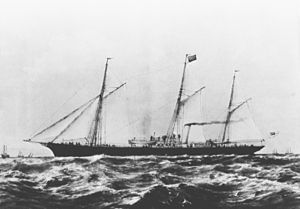
A steam yacht is a class of luxury or commercial yacht with primary or secondary steam propulsion in addition to the sails usually carried by yachts.
Origin of the name
Earliest steam yachts, luxury yachts, commercial yachts, naval yachts.
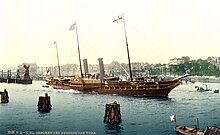
The English steamboat entrepreneur George Dodd (1783–1827) used the term "steam yacht" to describe the steamer Thames , ex Duke of Argyle . Her service on the river had first been advertised on 22 June 1815 as "Thames Steam Yacht", intended to emphasise how luxurious these vessels were. [1] [2]
The first two private steam yachts known were:
- Endeavour , a wooden paddle steamer registered 28 January 1828 by builders Rawlinson and Lyon, Lambeth , 75’6” x 12’ x 7’2”, 25 tons with a 20 HP Maudslay patent [3] oscillating engine with two cylinders 20in. dia. X 2 ft. stroke, and registered to the eminent English engineer Henry Maudslay , [4] London on 21 February 1828, who used her as his private steam yacht. The eminent Scottish engineer James Nasmyth mentions a trip aboard her to Richmond. [5]
- Swift , a wooden sailing smack built in 1803 at Bridport by Booles & Good, not registered. Unknown owners at Leith in 1804; documents missing. [6] Converted to a paddle steamer, described as a steam yacht, and registered by T. West, H. Bellingham, E. H. Creasey and others of Brighton on 21 August 1822 at Shoreham-by-Sea , 106’5” x 23’1” x 10’8”, 143 tons. They ran her as a ferry between Brighton and Dieppe . [7] [8] She was sold to G. Crichton, R. Ogilvie & others in Leith in February 1824. [9] Crichton & Ogilvie were well-known managers. [10] She was sold to H. Templer in London in September 1827 [11] and finally to Turkey in October 1828 when she became the Sultan's steam yacht Surat , [12] later taken into the Ottoman Navy as its first steam vessel.
Thomas Assheton Smith II was excluded from the Royal Yacht Club for his advocacy of the steam yacht, eight of which he commissioned between 1830 and 1851, beginning with the Menai . [13] [14] In cooperation with the Scottish engineer Robert Napier , whose Govan, Glasgow yard built a number of them, Smith did much to improve the hull design of steam yachts. [15] After 1856, when the Royal Yacht Squadron (the Club became Squadron in 1833) removed their edict, steam yacht building began to multiply. [16]
In England around 1901, some steam-powered fairground swings attempted to recreate the steam yacht experience; one example was built by the fairground equipment engineer Frederick Savage. [17]
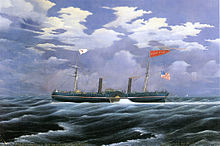
The term "steam yacht" encompasses vessels of several distinct uses, but of similar design.
A luxury yacht in the modern sense is a vessel owned privately and used for pleasure or non-commercial purposes. Steam yachts of this type came to prominence from the 1840s to the early-20th century in Europe . The first British royal yacht was Victoria & Albert of 1843. Nominally the first steam yacht in the United States was Cornelius Vanderbilt 's North Star , launched in 1854; however, this was actually a full-size steamship fitted out for the personal use of Vanderbilt and his family, and left no legacy on steam yacht design. [18] The first true steam yachts known to have been built in the United States, Leonard Jerome ' s Clara Clarita and R. F. Loper ' s Wave , were completed in 1864. [18]
Steam yachts were commissioned by wealthy individuals and often heads of state as extravagant symbols of wealth and/or power. [19] They were usually built with similar hull-lines to clipper ships , with an ornate bow structure and a low, smooth freeboard. Main propulsion usually came from one or two steam engines, later of compound type, or in even later, very large yachts, triple expansion or turbines . Steam yachts usually carried rigging for sails, originally as an auxiliary propulsion system, but later more for show and naval tradition. Private steam yachts were capable of long seagoing voyages, but their owners' needs and habits saw most stay near to the coast. Inland seas such as the Baltic and the Mediterranean were popular areas for using steam yachts.
Statistics show that Clydeside was the premier building area for steam yachts in the United Kingdom: 43 shipbuilding yards on Clydeside built 190 steam yachts between 1830 and 1935. [ citation needed ] Scotts Shipbuilding & Engineering Co Ltd of Greenock Scotland built 23 steam yachts between 1876 and 1904. [20]
The auxiliary steam yacht is a class of steam yacht in the luxury category. In 1876-77, British politician Thomas Brassey took his wife and children on a world cruise in their newly built yacht, the 532 ton Sunbeam . Brassey preferred sail as the primary source of motive power, but knew from years of experience the advantages of steam power, when wind and tide made progress difficult. Sunbeam was, therefore, designed as a "steam auxiliary", capable of covering long distances between coaling stations under her fully rigged sail area of 9200 square yards, but with enough fuel to steam for up to 20 days if necessary (she could carry 80 tons of coal). Their trip was made famous by a book written and published by his wife Annie Brassey - A Voyage in the Sunbeam, our Home on the Ocean for Eleven Months . Within a few years other yachts were built for owners with a similar sense of adventure, famously Lancashire Witch for Sir Thomas George Fermor-Hesketh, 7th Baronet and Wanderer for Charles Joseph Lambert. These sailing yachts, with steam auxiliary power, were more expensive to build and run, but gave the owners the freedom to roam the world without necessarily planning their routes via the network of coaling stations in existence at this time. In addition the yacht masters were not totally reliant on the quality of the steaming coal available to them, that could at times be questionable. When not in steam, the funnel on the auxiliary yacht would be lowered and the propeller feathered to reduce drag. [21]
Those of the second class of steam yacht were built for commercial use, but gained the 'yacht' title due to their size and design similarity with the private vessels and because they were not constructed to be mainly cargo- or passenger-carrying vessels, but as versatile, low- draft ships capable of working local coastal routes. This is closer to the original meaning of the word "yacht", coming from the Dutch term Jacht , describing a small, fast commercial vessel. The distinction between a commercial steam yacht and a coastal trading vessel is not a clear one, but the latter term usually implies a mainly cargo-carrying ship. Steam yachts were often run by packet companies operating regular, timetabled services between islands or coastal towns. Steam yachts were widely used in the whaling trade.
The light, fast design of a steam yacht was ideal for chasing whales, and the lack of a large amount of cargo space did not matter as whaling produced few bulky products. Commercial steam yachts were rarely as ornate or luxurious as their private counterparts, with simpler, more rugged lines and usually a more practical sailing rig. Steam yachts used in the whaling trade often had reinforced hulls to allow them to operate amongst the ice of frozen waters.
This meant that several whaling-yachts crossed the definition from commercial to private yacht in later life when they were bought for polar exploration work. Since these expeditions were, by and large, privately funded the ships used became, by definition, private steam yachts and many were registered with the 'SY' prefix used for such craft. The Aurora , Morning , Nimrod , Terra Nova and the Quest are all examples of commercial vessels that went on to become steam yachts used during the Heroic Age of Antarctic Exploration . It was common for expedition leaders to be members of a yacht club , so many of these ships were registered to a civilian club and flew a club burgee (and a blue ensign in the case of British steam yachts). Ernest Shackleton's ship Endurance and Roald Amundsen's Fram are unusual cases of vessels being purpose-built as icebreaking private steam yachts. Endurance was originally built for conducting tourist cruises of the Arctic, bringing her close to the definition of a yacht in the modern sense.
The Royal Navy used small numbers of steam yacht-type vessels from the Victorian era onwards to transport men and equipment in harbour, act as coastal escorts for larger ships and for training and exercises. A good example of this was the iron p.s. Fire Queen built for the entrepreneur Thomas Assheton Smith (II) (1776–1858), (his first of three Fire Queen s) by Robert Napier, Govan, Glasgow and launched on 27 July 1844, Napier Yard No 5, engine No 88. [22] She was bought by the British Admiralty in July 1847 for £5,000 for use as a tender; there is an illustration (incorrectly captioned) of her in that role. [23] She was sold on 4 August 1883 for £1,100 by the Admiralty to Castle the shipbreakers. [24] Fire Queen was replaced by the Admiralty by the former Steam yacht Candace , launched on 23 September 1881 by Ramage & Ferguson, Leith, bought by the Admiralty in 1882 and then duly renamed Fire Queen . [24]

In the First World War vessels such as these and several requisitioned private yachts were used on anti- U-boat patrols and for minesweeping . It became clear that the naval trawler was more suited to these kinds of tasks.
Steam yachts often used the ship prefix SY , but some were alternatively described as screw schooner , if they carried schooner rig. A fine example of the screw schooner is the 125 year old British Amazon , built at Southampton in 1885 from designs by the renowned Dixon Kemp and still in use in the USA after crossing the Atlantic in 2009, although diesel-propelled since 1937. She was photographed on Columbus Day 2009 on a mooring near the Herreshoff Marine Museum in Bristol, Rhode Island . [25]
Aurora built by Alexander Stephen & Sons Ltd, Glasgow in 1876 (a former whaling-yacht turned Antarctic exploration vessel) is a notable example of the class, as are the Victorian era yachts used by European monarchs , such as the HMY Victoria and Albert III and the SMY Hohenzollern . One of the oldest steam yachts, and one of the few still surviving today, is the Kheideval Yacht, Mahroussa , which was built in 1865 and was maintained in seaworthy condition by the Egyptian government.
The Hildegarde and Hiawatha were steam yachts chartered by the Ministry of Agriculture, Fisheries and Food (United Kingdom) - Directorate of Fisheries, now known as the Centre for Environment, Fisheries and Aquaculture Science (Cefas) between 1912 and 1914 to carry out fishery investigations. [26] Before the First World War , the SY Hildegarde was renamed as the Managem . On 15 January 1917 she was requisitioned by the Admiralty and armed with a 12 pdr naval gun. Notably she was stationed off Atlit in Israel and used to relay espionage messages from operatives onshore (and briefly used by the Jewish "Nili" espionage group).

Related Research Articles

A steamship , often referred to as a steamer , is a type of steam-powered vessel, typically ocean-faring and seaworthy, that is propelled by one or more steam engines that typically move (turn) propellers or paddlewheels. The first steamships came into practical usage during the early 1800s; however, there were exceptions that came before. Steamships usually use the prefix designations of "PS" for paddle steamer or "SS" for screw steamer . As paddle steamers became less common, "SS" is incorrectly assumed by many to stand for "steamship". Ships powered by internal combustion engines use a prefix such as "MV" for motor vessel , so it is not correct to use "SS" for most modern vessels.

Thomas Brassey, 1st Earl Brassey , was a British Liberal Party politician, Governor of Victoria and founder of The Naval Annual .
HMS Sultana was a small Royal Navy schooner that patrolled the American coast from 1768 through 1772. Her role was to prevent smuggling and to collect customs duties. She was retired and sold in 1773 when unrest in Britain's American colonies required larger, better armed patrol craft.

C.A. Thayer is a schooner built in 1895 near Eureka, California. The schooner has been preserved and open to the public at the San Francisco Maritime National Historical Park since 1963. She is one of the last survivors of the sailing schooners in the West coast lumber trade to San Francisco from Washington, Oregon, and Northern California. She was designated a National Historic Landmark on 13 November 1966.

USS Mayflower (PY-1) was a 275 ft (84 m), 2,690 t (2,650 LT) motor vessel originally built as a private yacht that went on to serve in a variety of military, governmental, and commercial roles.

Robert Napier was a Scottish marine engineer known for his contributions to Clyde shipbuilding.

HMS Waterwitch was a British hydrographic survey vessel active in eastern Asian waters from 1894 to 1912. She was a wooden vessel, purchased from a private owner specifically for survey work. She was lost in a collision in Singapore harbour in 1912.

HMS Eclipse was a Royal Navy Cruizer -class brig-sloop built by John King at Dover and launched in 1807. She served off Portugal and then in the Indian Ocean at the capture of the Île de France. Shortly thereafter she captured Tamatave. She was sold for mercantile service in 1815. She traded with India until 1823. Then between 1823 and 1845 she made seven voyages as a whaler.

George Lawley & Son was a shipbuilding firm operating in Massachusetts from 1866 to 1945. It began in Scituate, then moved to Boston. After founder George Lawley (1823–1915) retired in 1890, his son, grandson and great-grandson upheld the business, which continued until 1945. Of the hundreds of ships built by the Lawleys, highlights include the yachts Puritan and Mayflower , respective winners of the 1885 and 1886 America's Cup.
St Clare John Byrne (1831-1915) was a British naval architect, who specialized in the design of luxury yachts during the late Victorian and early Edwardian period.
William Patterson Shipbuilders was a major shipbuilder in Bristol, England, during the 19th century and an innovator in ship construction, producing both the SS Great Western and SS Great Britain , fine lined yachts and a small number of warships.

HMS Rover was a Royal Navy Cruizer -class brig-sloop laid down in 1804 but not launched until 1808. She served in the North Sea, off the north coast of Spain, in the Channel, and on the North American station. She captured two letters-of-marque and numerous merchant vessels before being laid-up in 1815. She then sat unused until she was sold in 1828. She became a whaler that made four voyages to the British southern whale fishery between 1830 and 1848. She was last listed in 1848.

Sunbeam , a British luxury yacht launched in 1874, became famous when Annie Brassey, the wife of its owner Thomas Brassey, published a book describing their adventures during a world cruise. The book, titled A Voyage in the Sunbeam, our Home on the Ocean for Eleven Months , became a best seller and was translated into many languages.
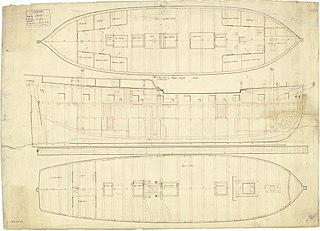
HMS Rattler was a 16-gun sloop of the Royal Navy. Launched in March 1783, she saw service in the Leeward Islands and Nova Scotia before being paid off in 1792 and sold to whaling company Samuel Enderby & Sons. She made two voyages as a whaler and two as a slave ship before she was condemned in the Americas as unseaworthy in 1802. She returned to service though, sailing as a whaler in the northern whale fishery, sailing out of Leith. She continued whaling until ice crushed her in June 1830.

HMS Indian was a Bermuda-built sloop launched in 1805. She captured several small privateers while on the West Indies and Halifax stations before the Royal Navy sold her in 1817. Her main claim to fame, however, is that she was the first command of future Rear-Admiral Charles Austen, who was also the brother of the famed novelist Jane Austen. After the Navy sold her she became a whaler for Samuel Enderby & Sons. She apparently sailed for them until the mid-1830s; she then sailed for other owners until mid-1847, for a total of nine whaling voyages since leaving naval service.

HMS Alderney was a 10-gun Alderney -class sloop of the Royal Navy that saw active service during the Seven Years' War and the American Revolutionary War. Launched in 1757, she was principally deployed in the North Sea to protect British fishing fleets and merchant trade. In this capacity she captured two American privateers, Hawk in 1779 and the 12-gun Lady Washington in 1780. She was removed from Navy service at the conclusion of the American Revolutionary War, and sold into private hands at Deptford Dockyard on 1 May 1783. She became the whaler Alderney that operated between 1784 and 1797, when the Spaniards captured her off Chile.
HMS Coquette was launched in 1807 and spent her naval career patrolling in the Channel and escorting convoys. In 1813 she engaged an American privateer in a notable but inconclusive single-ship action. The Navy put Coquette in ordinary in 1814 and sold her in 1817. She became a whaler and made five whaling voyages to the British southern whale fishery before she was lost in 1835 on her sixth.
Norfolk was built in France in 1784 under a different name. The British captured her c. 1800 and she made some voyages as a West Indiaman. She also made a cruise as a privateer. Between 1803 and 1808 she served the Royal Navy as an armed defense and hired armed ship on the Leith Station. She spent her time escorting convoys in the North Sea and captured one French privateer. After her naval service, between 1808 and 1814 Norfolk was a London-based transport. From 1814 to 1820 she made four voyages as a whaler in the British southern whale fishery. She was last listed in 1823.
The SY Hildegarde and the SY Hiawatha were steam yachts chartered by the Ministry of Agriculture, Fisheries and Food - Directorate of Fisheries, now known as the Centre for Environment, Fisheries and Aquaculture Science (Cefas) between 1912 and 1914 to carry out fishery investigations.
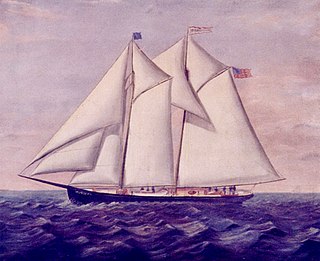
The Thomas F. Bayard was a 19th-century Delaware River pilot schooner built by C. & R. Poillon shipyard in 1880. She spent sixteen years as a pilot boat before being sold during the Yukon Gold Rush in 1897. She was sold again in 1906 for Seal hunting, then purchased by the Department of Marine & Fisheries where she guided freighters into New Westminster, British Columbia for 43 years. She was then acquired by the Vancouver Maritime Museum in 1978. When she sank at her mooring in 2002, the International Yacht Restoration School, Mystic Seaport and the Vancouver Maritime Museum, removed the vessel in pieces for the archeological teams to study and document the remains of her hull. The Thomas F. Bayard Collection , at the Vancouver Maritime Museum, contains the documents, history and preservation efforts.
- ↑ Parliamentary Report of 24 June 1817, 29
- ↑ British Patent No. 3050, 1807, "Steam Engines"
- ↑ The National Archives BT107/52, No. 55
- ↑ Nasmyth, James (1883). James Nasmyth, Engineer: An Autobiography . London: John Murray . p. not cited.
- ↑ Hawks, Fred, World Ship Society CD No. 2
- ↑ The National Archives, BT107/169, Shoreham No.15.
- ↑ Parliamentary Report 1822, page 201.
- ↑ BT107/408.
- ↑ Martine, John (1888). Reminiscences of the port and town of Leith . Edinburgh: John Martine. p. 4.
- ↑ "Piece reference BT 107/51—Registry of Shipping and Seamen: Transcripts and Transactions, Series I—London Foreign Trade—Ports: 277 - 503, No. 379" . The Catalogue . The National Archives .
- ↑ "Piece reference BT 107/51—Registry of Shipping and Seamen: Transcripts and Transactions, Series I—London Foreign Trade—Ports: 277 - 503, No. 383" . The Catalogue . The National Archives .
- ↑ Boase, George Clement (1898). "Smith, Thomas Assheton" . Dictionary of National Biography . Vol. 53. pp. 134–135.
- ↑ Dawson, C (August 2006). "Thomas Assheton Smith's Steam Yachts". The Mariner's Mirror . 92 (3).
- ↑ Eardley-Wilmot, Sir John E., ed. (1860). Reminiscences of the late Thomas Assheton Smith, Esq . London: John Murray. p. 55 .
- ↑ Kemp, Dixon , Steam Yachts , RINA 24th Session, 15 March 1883
- ↑ "Fairground Sale Steams Ahead" . BBC News online. 11 October 2002.
- 1 2 Stephens, William Picard (1904). "Steam Yachting in America". American Yachting . New York: The MacMillan Company. pp. 399–342 .
- ↑ Marine Engineering . Vol. 4. Marine Publication Co. 1899. pp. 142–144.
- ↑ Two Centuries of Shipbuilding by the Scotts at Greenock . London: Scotts. 1906.
- ↑ Brassey, Earl Thomas (1917). Sunbeam RYS. Voyages & Experiences in Many Waters . London: John Murray. p. Chapter V.
- ↑ World Ship Society Yard List No 169/5.
- ↑ Gardiner, Robert, ed. (1993). The Advent of Steam: The Merchant Steamship Before 1900 . Conway's History of the Ship. London: Conway Maritime Press. p. 36. ISBN 0851776183 .
- 1 2 Lyon, David; Winfield, R (2004). The Sail and Steam Navy List: All the Ships of the Royal Navy, 1815-1889 . London: Chatham Publishing. p. 286. ISBN 1861760329 .
- ↑ "1885 British screw schooner Amazon at Bristol RI Columbus Day 2009" . Archived from the original on January 8, 2011 . Retrieved March 24, 2011 .
- ↑ MAFF (1992). The Directorate of Fisheries Research: Its Origins and Development . Ministry of Agriculture, Fisheries and Food, Lowestoft. 332pp.

Wilkins 42 ft Steam Schooner 1893 - Sold
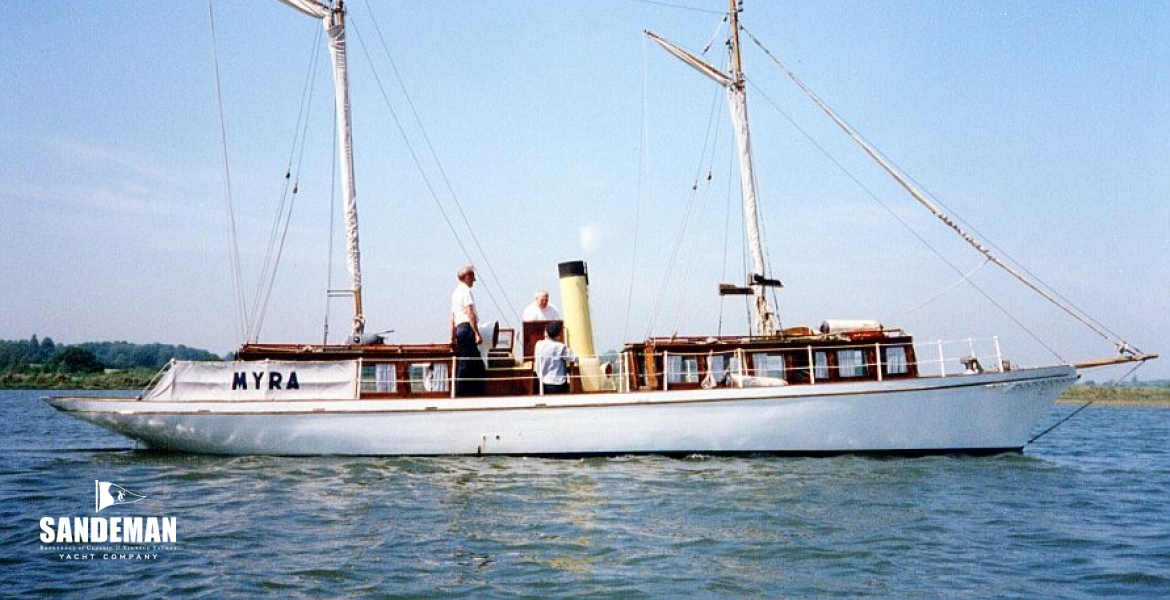
Wilkins 42 ft Steam Schooner 1893
| Designer | J E Wilkins |
|---|---|
| Builder | J A Houston, Rowhedge Essex |
| Date | 1893 |
| Length overall | 50 ft 0 in / 15.25 m |
| Length deck | 42 ft 0 in / 12.8 m |
| Length waterline | 38 ft 1 in / 11.6 m |
|---|---|
| Beam | 9 ft 3 in / 2.82 m |
| Draft | 4 ft 2 in / 1.26 m |
| Displacement | 12.7 Tonnes |
| Construction | Teak planking on oak frames |
| Engine | Triple expansion steam installed 1977 |
|---|---|
| Location | United Kingdom |
| Price | Sold |
These details are provisional and may be amended
BROKER'S COMMENTS
MYRA is about as elegant as any yacht can be; built of teak bronze and iron in 1893. She is an extremely exciting project with many of her original fittings and details intact but this should not be undertaken lightly because of the extent of the work needed. We believe MYRA to be totally unique and therefore her next owner will be rewarded by a vessel that surely defines the oft over used term “Gentleman’s Motor Yacht”.
Interested in MYRA in more detail.
Enquire About MYRA Download PDF Specification
Restoration project
This vessel is offered for sale as a restoration project and some of the pictures used are historical and do not necessarily show the vessel as she is today.
Built in 1893 for wealthy young man and serial steam yacht owner Willie Mackenzie of Colchester by J A Houston of Rowhedge; MYRA is a steam schooner, carvel built of teak and gaff rigged. The original steam compound engine was built by Mumford of Colchester, one of the world\'s largest steam engine builders of the late 19th Century. This remarkable vessel was used by Mr Mackenzie in a variety of roles both as a vessel for day trips out with friends and admirers such pleasures much enjoyed in those days as well with accommodation for 4 and a sea going capability; more extended voyages. Her second owner, one WJP Peacock used her from 1896 to the outbreak of war in 1914 for watching yacht racing and again for day sailing and longer trips - functions she could perform again in great style. Another story has it that she went over to Paris – to win 1st prize in the maritime section of the Great Exhibition of 1903, later plying the Seine on day trips but this is uncorroborated. Her subsequent owners from 1920 were: R S Heard of Swansea and J Hughes Rice of Newton, Glamorgan, who owned her until at least 1932. Details of her history thereafter are scant. Between the wars Myra had been fitted with a petrol engine but kept her schooner rig. After WWII she declined through neglect – left it seems for many years in Ipswich dock sans engine. It was there, by then in the 1970s that Peter Darby owner of Everson’s boatyard at Woodbridge found and after long negotiation, bought her. Once agreed he had her moved quickly by road to his own yard, where close inspection revealed that in spite of long immersion in brackish waters the hull condition was exceptionally good, requiring only limited re planking but total re caulking. Substantial refitting included removal of the petrol engine and concrete ballast as well as treating and replacement thereof. The deck caulking was completely stripped out and finding the timbers good, they were treated and re caulked. The interior was scraped back to bare wood, re varnished and deck houses re glazed. The original steam engine long gone, all sorts of options for an engine were considered, given Peter Darby her owner was a builder of steam engines himself. Looking for something suitable he found an awesome triple expansion engine, commercially built to deep sea standards; possibly a college training engine, which fine engine he bought and fitted – with remarkable ease as it happens. To power it initially he created a new oil fired 3 drum water tube boiler but replaced this later with a return tube boiler of Scotch design. It is worth noting that the combined size of this boiler and engine required some repositioning of the propulsion system further forward in the vessel, with some consequent re positioning of cabin spaces. MYRA made her second “maiden” voyage – the first time she’d steamed since 1920 on 18th December 1979. She was subsequently refitted with her schooner rig and is believed to have steamed regularly up to around 2005. pictures exist of her sailing hard pressed - and her surprising performance confirmed by her previous owner. More recently she was acquired by the Schiffs und Yachtwerft Dresden where further work was carried out and then acquired by her current owners in 2012.
Construction and condition
The teak carvel topside teak planking is considered to be 95% excellent and two large sections have been stripped to show the beautiful colour and patina of the 120 year old teak. Below the waterline again the teak planking is mostly good, but the garboards – believed to be of elm need attention. Fastenings are copper and bronze. The deck is not so good and the 1½ inch pine, swept deck planking - possibly the original, will need to be replaced. Both deck houses are complete and sound but require full cosmetic refurbishment. Cabin tops are teak (laid fore/aft) doubled with diagonal teak beneath. The grown oak frames and steam bent oak timbers do need significant work with about half needing repair, doubling or replacement. The keel is straight and well supported on a 40 ft flatbed trailer.
Rig spars and sails
- Schooner rig with loose footed sails and furling by brailing - The masts need work or replacing but have all the fittings. - The gaffs are varnished and look good - Galvanized rigging and all blocks are present but need attention - Main sail sheet track well aft on the counter - Foresail tacks with a Lazy sheet - Wickham Martin type Jib furling - The sails are scruffy but will provide good patterns
Deck fittings
- All deck fittings for sailing except ship\'s wheel are present - Additional fittings include the bronze coaling hatches, period anchor winch and capstan - Forged iron tiller enabling steering from the counter - Bronze chain plates - Ship\'s bell is in Rostock NE Germany and attempts are being made to repatriate
Engine, mechanical and electrical
- Triple expansion steam main engine - no maker’s plate apparent but probably by Sissons - Cylinders of 4.5 inch + 7 inch + 10 inch x 6 inch stroke - Engine is complete and has crosshead driven air pump for the condenser - Eccentric driven boiler feed pump and chain drive to a 12 volt generator - Remote control Stephenson reverse gear and regulator enables deck or engine room control - Engine complete but now not free so needs stripping cleaning and reassembly - Dry backed Scotch type Boiler, currently oil fired - Domestic type burner converted to 12 V - Steam donkey engine with own condenser and salt water pump powers a second generator - Generator for battery charging or lighting when main engine is stopped - 2 x Modern fuel tanks for paraffin or 28 sec heating oil are currently removed for access - 2 x Top up water tanks and the hot well water tank for boiler feed water - Water can also be fed by injector - Boiler certificate expired and the boiler will require attention or replacement - All fittings, gauges etc are available
Interior from forward
- Chain locker, with some storage, very pretty teak oval hatch - Head with period Downton pattern WC and bronze pumps currently discharging over side - J Stone fold away self draining basin with nickel plated taps, pump and all parts - Ladies fore cabin panelled in dark oak; 2 x berths, needs a full cosmetic restoration - Table with drop sides, fiddles and bottle storage - Engine room containing the propulsion and generating etc equipment - This space was originally just the boiler room - Aft cabin; 2 x berth and galley mostly teak interior of 1970 s vintage currently stripped out for access - All parts labelled for replacement if wanted - This cabin was originally the engine space plus crew quarters - Also in store; an early Simpson Lawrence stove and a classic pattern Patay galley pump - The Windermere kettle is in Rostock NE Germany - attempts are being made to repatriate - Lazarette mostly dedicated to the large diameter steering quadrant but with some storage
Owners notes and comments
MYRA is complete but needs new decks and a substantial restoration The original Mumford compound engine - or one identical from near MYRA’s home port is currently for sale at Preston Steam Services Ltd near Canterbury in the UK. If a potential purchaser would wish to fit a different steam or maybe diesel engine the owners would be willing to sell her without the existing machinery, which could be removed with ease having been installed only to facilitate the move from Dresden back to the UK. MYRA is currently on a 40 ft York artic trailer with air suspension, which is also available for sale by negotiation. She could very easily be delivered anywhere with road access; including USA as there are RoRo services to most parts of the world. Height with funnel etc removed is under 4 m. Assistance could be given to the new owner with moving if required. MYRA is listed as a project boat in need of restoration but once completed she would be a unique vessel and the belle of the ball at any regatta or gathering.
Contact us to discuss MYRA in more detail.
Your message was successfully sent.
Mobile No.:
These particulars have been prepared from information provided by the vendors and are intended as a general guide. The purchaser should confirm details of concern to them by survey or engineers inspection. The purchaser should also ensure that the purchase contract properly reflects their concerns and specifies details on which they wish to rely.
Sandeman Yacht Company
Brokerage of classic & vintage yachts.

STEAM YACHT LOUISE

120 Years on Lake Geneva!
The restored Steam Yacht Louise, built in 1902, allows you an opportunity to experience the elegance of Lake Geneva’s Golden Era. Her charm comes not only from polished brass and gleaming mahogany, but also from the engineer operating a vintage steam engine as you glide across the water. The Louise has two decks furnished with clear side curtains for inclement weather and an enclosed cabin area with wet bar and head. Treat your guests to an extraordinary experience aboard the Louise!
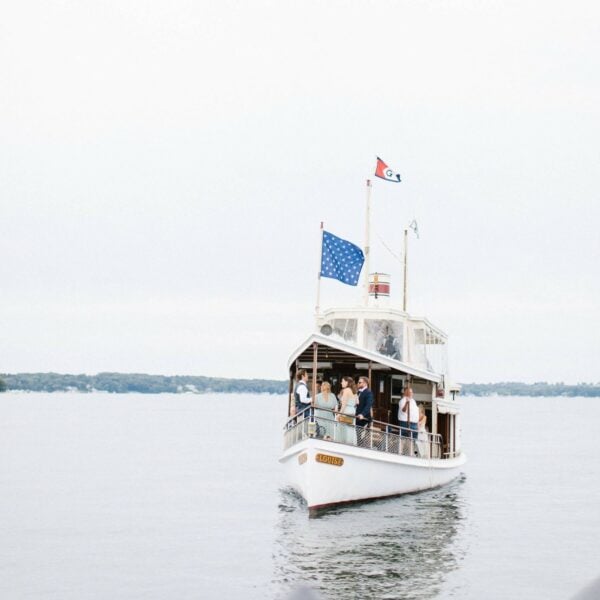
| Cocktails and Reception Maximum 50 | Table Seating Capacity Maximum N/A |
The Steam Yacht Louise is available day or night seven days a week for the full season. Call for availability.
Check out the North American Steam Boat Association and the Northwest Steam Society for great information regarding other steam projects.

PRIVATE EVENT PRICING
Includes 2 hours and up to 30 passengers
Includes 3 hours and up to 30 passengers
FLOOR PLANS
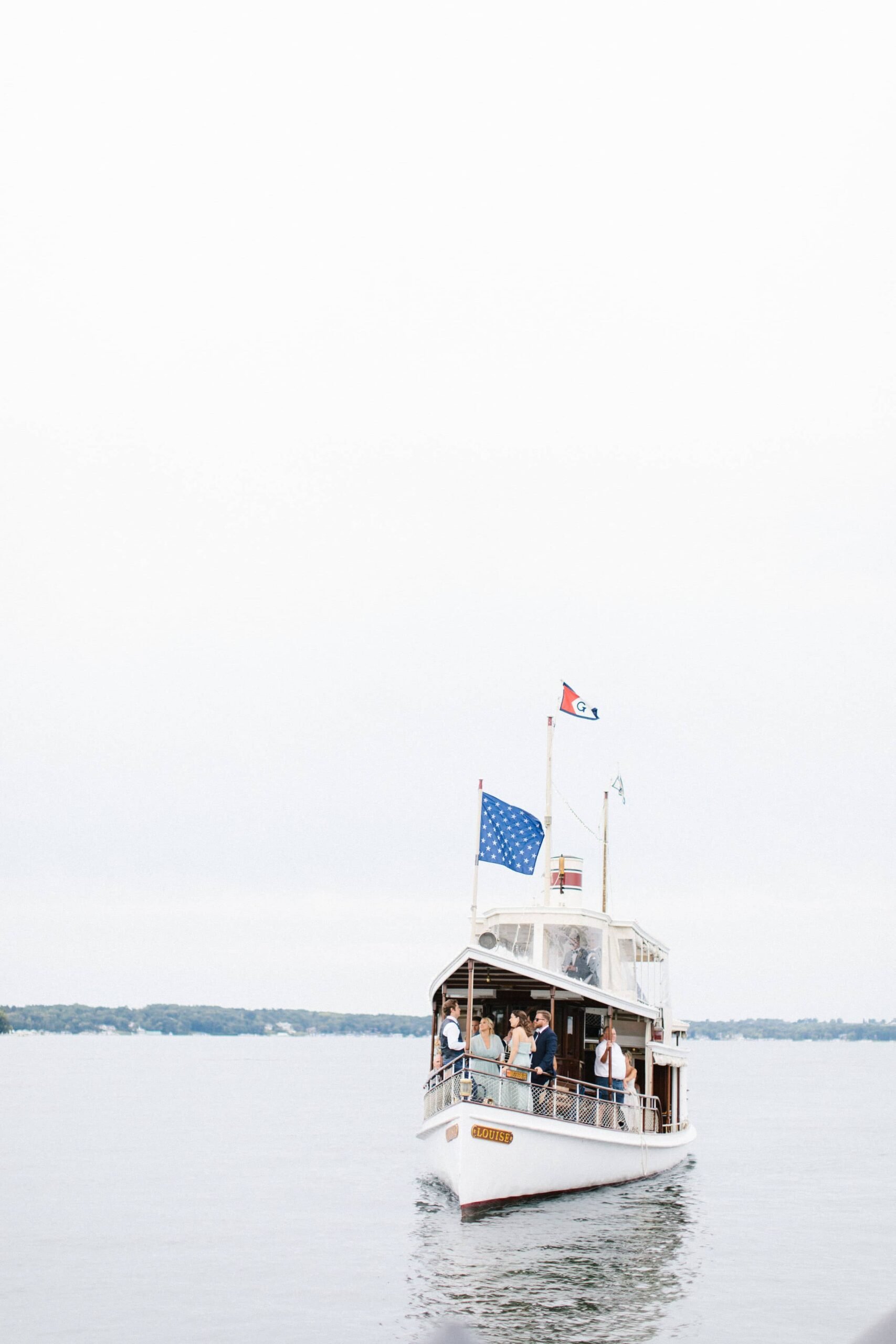
What a prickle…
We're sorry – it looks like something's gone wrong

Sign in to add this item to your wishlist, follow it, or mark it as ignored

| Interface | Full Audio | Subtitles | English | ✔ | ✔ | ✔ | French | ✔ | ✔ | Italian | ✔ | ✔ | German | ✔ | ✔ | Spanish - Spain | ✔ | ✔ |
|---|---|---|---|
| Japanese | ✔ | ✔ | |
| Korean | ✔ | ✔ | |
| Polish | ✔ | ✔ | |
| Portuguese - Brazil | ✔ | ✔ | |
| Russian | ✔ | ✔ | |
| Simplified Chinese | ✔ | ✔ | |
| Traditional Chinese | ✔ | ✔ | |
| Turkish | ✔ | ✔ | |
| Spanish - Latin America | ✔ | ✔ |
Planned Release Date: 2025
About this game, system requirements.
- OS: Windows 10 64bit
- Processor: Intel Core i3-8100 or AMD Ryzen 5 2600X
- Memory: 8 GB RAM
- Graphics: NVIDIA GeForce GTX 1660 Super or AMD Radeon RX VEGA 56 or Intel Arc A750
- DirectX: Version 12
- Storage: 30 GB available space
- Processor: Intel Core i5-10400 or AMD Ryzen 5 3600
- Memory: 16 GB RAM
- Graphics: NVIDIA GeForce RTX 3070 Ti or AMD Radeon RX 6750 XT or Intel Arc A770
More like this
You can write your own review for this product to share your experience with the community. Use the area above the purchase buttons on this page to write your review.

You can use this widget-maker to generate a bit of HTML that can be embedded in your website to easily allow customers to purchase this game on Steam.
Enter up to 375 characters to add a description to your widget:
Copy and paste the HTML below into your website to make the above widget appear

Popular user-defined tags for this product: (?)
Sign in to add your own tags to this product.


IMAGES
COMMENTS
The restoration took about six years. The steam engines underwent a fascinating reconstruction. In 2003, Delphine II was relaunched as the last and only large steam yacht in the world, but Bruynooghe's charter business was not successful. He put her up for sale in 2004 for € 46 million, reduced 12 years later to € 16 million.
A steam yacht is a class of luxury or commercial yacht with primary or secondary steam propulsion in addition to the sails usually carried by yachts.
SY Cangarda. 7 ft (2.1 m)-6"." The Cangarda is a 126-foot (38 m) long luxury steam yacht that was built in 1901 at the Pusey and Jones shipyard in Wilmington, Delaware. It is the only surviving U.S.-built steel steam yacht and one of only three similar yachts remaining worldwide. After years of service at sea, on inland rivers, on the Great ...
The classic yacht was originally equipped with triple Babcock & Wilcoz boilers, supplying power for her two 1,500-horsepower steam engines. The engine room received an update during a 2003 refit, and she was outfitted with two modern water-tube boilers, which now power the original engines.
The 101-year-old classic yacht that runs on steam. The SS Delphine is an iconic yacht that reached a major milestone in April 2021: celebrate its 100th birthday. Now, a year older, the yacht has been renovated on the inside but still uses steam to move around. "She is the only superyacht in the world still operating today with her quadruple ...
SS Delphine launched April 1921. Caption from Popular Mechanics magazine. SS Delphine is a yacht commissioned by Horace Dodge, co-founder of Dodge Brothers. The yacht was launched on 2 April 1921 Captained by Arthur A. Archer. [ 2] Power was originally supplied from three Babcock & Wilcox boilers [ 3] powering two 1,500-horsepower (1,100 kW ...
The massive yacht was built near Detroit in River Rouge, MI, by the Great Lakes Engineering Co., at a cost of over $2 million. Delphine is powered by twin quadruple-expansion steam engines that produce 1,500 horsepower each. Mr. Dodge designed these large engines, which still operate the yacht today. They turn only about 150 revolutions per ...
The SS Delphine Yacht, a product of the Roaring Twenties, was built by Great Lakes Engineering and designed by Gielow & Orr. It was initially constructed for Horace Dodge, co-founder of the American car brand Dodge. This yacht is powered by original Great Lakes Engineering Works steam engines and was equipped with modern boilers in 2003 ...
The 1901 steam yacht Cangarda was 136 feet long and 125 tons. Here, ULTIMATE RESTORATIONS host Bob McNeil builds the much smaller "launch," or motorboat, that accompanies the Cangarda.
SS Delphine: the last big steam yacht Recognisable by her elegantly inverted bow, slender shape (78.5m long for a beam of 10.83m) and equipped with three boilers powering two 1,500hp quadruple expansion engines, the SS Delphine is the last steam-powered yacht still sailing in her original configuration.
Several years ago, Paul Madden surveyed the classic yacht SS Delphine at a shipyard in Portugal on behalf of a client from Singapore, and that is the basis o...
Steam yachts of a century ago, from Jeff Cole's collection. Dodo, Valhalla and Consuelo. Today's gallery of photos are of steam yachts, and they belong to a collection that Jeff Cole acquired back when he was a teenager. Except for Dodo he says they are all private steam yachts, mostly photographed at Cowes, and wonders what what happened ...
A steam yacht is a class of luxury or commercial yacht with primary or secondary steam propulsion in addition to the sails usually carried by yachts.
Built in 1893 for wealthy young man and serial steam yacht owner Willie Mackenzie of Colchester by J A Houston of Rowhedge; MYRA is a steam schooner, carvel built of teak and gaff rigged. The original steam compound engine was built by Mumford of Colchester, one of the world\'s largest steam engine builders of the late 19th Century.
118 Years on Geneva Lake! The restored Steam Yacht Louise, built in 1902, allows you an opportunity to experience the elegance of Lake Geneva's Golden Era.
Tour of the restored Steam Yacht (S.Y.) Cangarda while she was at Tinsley Island in the San Joaquin River Delta, near Stockton, California in September of 20...
The National Trust's Steam Yacht Gondola is a rebuilt Victorian steam-powered yacht on Coniston Water in the Lake District.
Find information and specifications on the best selling vintage steam yacht models in the market and choose the perfect one for you with itBoat!
The Medea is a 1904 steam yacht preserved in the Maritime Museum of San Diego, United States. Named after Medea, the wife of Jason, she was built in a record 51 days on the Clyde at Alexander Stephen and Sons shipyard at Linthouse by John Stephen for William Macalister Hall of Torrisdale Castle, Scotland.
Rover (yacht) ... The Rover was a steam-powered yacht built in 1930 by Alexander Stephen and Sons in Glasgow, Scotland for Lord Inchcape, then chairman of the Peninsular and Oriental Steam Navigation Company (P&O).
SS Delphine is the largest steam ship ever built in the United States. She was ordered by Horace Dodge and named after his only daughter Delphine. She had an impressive restoration completed between 1997 and 2003 with no expense spared. Accommodation is for 26 guests in two VIP suites, nine double staterooms and a four-bunk cabin. Power comes ...
Get ready to experience the thrill of managing a sailing yacht with realistic controls that were developed with input from actual voyagers' stories, yet simplified for any player to enjoy. Navigating through cold and hostile environments has always been vital to northern people, and WILL, a fearless man who grew up on the sea, embodies this ...
The Bayesian, a 56-meter (184-foot) British-flagged yacht, went down in a storm early Monday as it was moored about a kilometer (half a mile) offshore. Civil protection officials said they believe ...
The Steam Yacht Ena is a steam yacht that was built in 1900 for Thomas Dibbs, the commodore of the Royal Sydney Yacht Squadron. It was used as his private vessel for entertaining guests on Sydney Harbour and Pittwater until the beginning of World War I.